Legions Imperialis – Let us build a city
After providing an overview on the Civitas Imperialis range by Games Workshop we want to take a look into how terrain works in Legions Imperialis, what we need and what might have changed in comparison to for example Adeptus Titanicus.
The most obvious difference is, that the eye-level of the units has changed. While in Titanicus you have maniples of Titans, and you need buildings tall enough to provide cover for these huge machines, this gets much closer to ground with Legions Imperialis.
- In general the missions for Legions Imperialis are written with 5' by 4' (60" by 48") and 3.000 points in mind. Smaller games can easily be played on smaller tables - just like they did in the reports on Warhammer+. And there is no reason to cut up your 6' by 4', just use it as a side board, fold it, whatever. Stay flexible!
- The game uses true line of sight, meaning you use the eye level of the units you want to command, to see what they can see. Certain modifiers apply, for obstructing blocks line of sight even if you can see the enemy and certain parts of the miniatures, like gun barrels or other things extending from the base / the model itself, don't count for this.
- There are different types of terrain: Difficult Terrain (difficult to move through and fight in), Obstructing Terrain (harder difficult terrain, incl. blockage of line of sight), Dangerous Terrain (causes damage to the detachments), (Reinforced) Obstacles (basically scatter terrain that creates cover, but fitted to the Epic scale), Impassable Terrain (simply impassable), Rivers (count depending on detachments size as difficult, impassable or open terrain), Cliffs (an obstacle that is depending on the type of detachment impassable) and Structures (types of building, that can be garrisoned and destroyed, classified in 4 different types). Terrain can be combined types.
That just as a base line. Now let us look how the game designers themself present the tables for the games. All of them use the new tile system and create squares and street grids, that feel very much like Manhattan or Mannheim.
If you intend to use the tiles, be aware that you will need four of the boxes for the full size table of 5 by 4 (20 tiles, each box covers 6). Due to their scale they are pretty much unique as a physical product. You can obviously find STLs. I anyhow would recommend a gaming mat, as it is much easier to store. I don't have any preferences on the manufacturers, but I would suggest spending money for either cloth or neopren / mouse pad material and stay away from posters, pvc or similar material, due to the glossy finish.
Beyond that, the measurements of the segments (12" x 12 " / 305 mm x 305 mm) give you roads that are 2,5" or about 6,5 cm wide, and with the pavement substracted and a bit of room, I would suggest that L-shaped ruins or smaller buildings shouldn't be wider than 3" per side to be flexibel.
But what is it, we extract from the information and rules given by the core rulebook? So far, as further supplements might introduce battle zones, new unit types etc. that will change the need for different scenarios.
- As terrain can mostly be interacted with, units placed or moved through, you want to design it in a way, that the models can interact with, but mostly that it is clear, if a unit is within that type of area or not. For this I would either suggest basing your terrain pieces or build them in a way, that they clear outline the area (for example going with L or U-shaped buildings or ruins that you can draw lines from for their borders). As you can see in the second picture, already a few bits and pieces can create a L-shaped corner that clearly shows the borders of an area. The second and third picture show the Imperial Palace range by Grim Dark Terrain.
- Terrain, especially structures can be garrisoned or destroyed. Keep that in mind. For example use surfaces that make it possible to place units in them, to benefit from their cover. And maybe don't glue the top level or have an alternate piece of a similar footprint to show that it was damaged / destroyed.
- Keep the terrain in a reasonable size. With Titanicus we went for tall buildings, structure that would obscure the line of sight of Warlord Titans and provide partially cover for Warmasters and such. You don't need that with Legions Imperialis. You need less taller structures, but wider foot prints, to have whole detachments be inside those. But just to give you an idea, where you want to go for the height of your buildings, a few comparison shots.
What is it you will need, depending on the design of your table. If you want to go for an Industrial City, a war-torn ruin city or maybe not even a city at all, but a Forge World, a desert planet like Tallarn (post destruction by the Iron Warriors). Because even with all these buildings and kits availabe, there is nothing wrong with some rock faces, hills, forests (from leaf trees to weird alien botanica) an such. I got myself a while ago from the Battlefield in a Box range a few rocks and hills, and they work quite well with the Epic scale, just need to add some buildings like a mining infrastructure or terra-forming equipment by the Mechanicum.
Yet, for the beginning I would suggest the following as a flexible terrain collection:
- 3 to 5 medium sized buildings (up to roughly 3x3 or 4x2 tiles in footprint, and up to 3 stories high)
- 1 or 2 large buildings (4 by 4, something present)
- 12 to 15 L-shaped ruines (with sides between 1 to 3 tiles long), as you can use between two and four of them to mark an area, and those 12 to 15 ruins would give you around 5 to 6 clearly marked areas. And you don't need to mark areas if you don't want to, just use them as blockers for line of sight
- 4 to 8 smaller terrain pieces, like ruins, obstacles etc. to block movement but not line of sight
- 6 objective markers. This can be anything, from Space Marine Banners (the small ones from the back packs), Vexillas, spare titan heads from Titanicus, the free Warhammer store Rhino. Just something to replace those card board markers.
In the next articles, we will pick up terrain building. Cover a few ideas for structures and ruins, partially using the Civitas Imperialis or Grim Dark Terrain range, and include suggestions on their use with the rules regarding garrisons and structures.
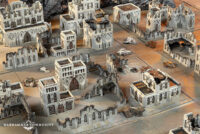
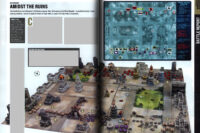
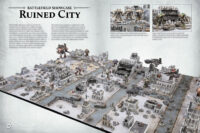
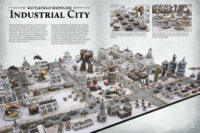
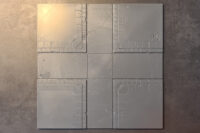
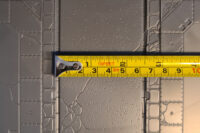
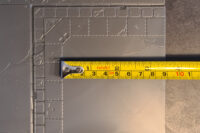
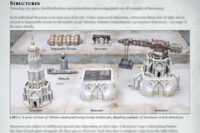
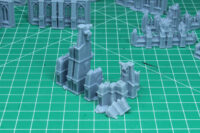
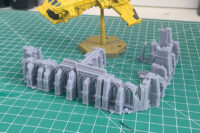
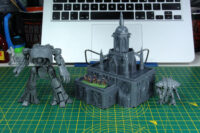
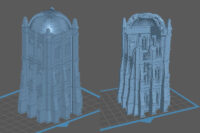
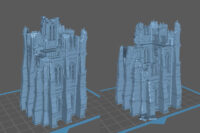
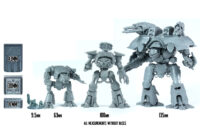
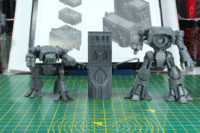
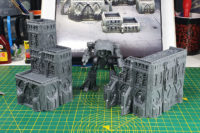
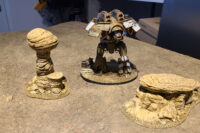
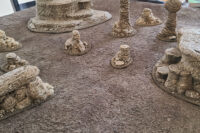
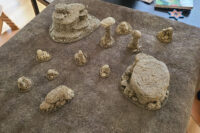












June 4th, 2025 - 10:46
thanks for the useful article! Just getting into AT and its handy to see what terrain is available.
Curious – whats the great looking textured mat in the last photos?
June 6th, 2025 - 16:35
It’s just a painter’s fleece that I painted up
https://www.chaosbunker.de/en/2023/04/08/terrain-basics-a-desert-table/